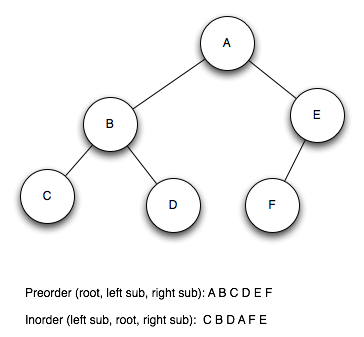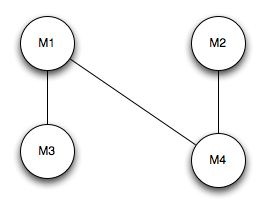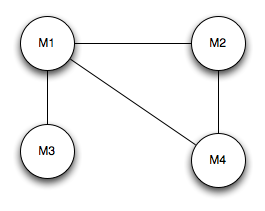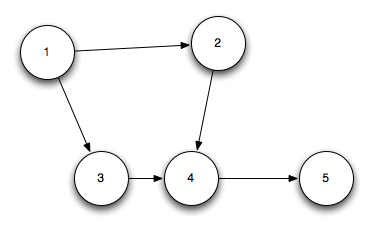5-6. In breadth-first and depth-first search, an undiscovered node is marked discovered when it is first encountered, and marked processed when it has been completely searched. At any given moment, several nodes might be simultaneously in the discovered state.
(a) Describe a graph on n vertices and a particular starting vertex v such that Θ(n) nodes are simultaneously in the discovered state during a breadth-first search starting from v.
(b) Describe a graph on n vertices and a particular starting vertex v such that Θ(n) nodes are simultaneously in the discovered state during a depth-first search starting from v.
(c) Describe a graph on n vertices and a particular starting vertex v such that at some point Θ(n) nodes remain undiscovered, while Θ(n) nodes have been processed during a depth-first search starting from v. (Note, there may also be discovered nodes.)
Solution. (a) A graph with n vertices and a depth of one where no node was processed yet which started at the root.
(b) A graph with n vertices and a depth of n where no node was processed yet which started at the root.
(c) E.g. the graph of (b) which is processed up to n/2.
5-7. Given pre-order and in-order traversals of a binary tree, is it possible to reconstruct the tree? If so, sketch an algorithm to do it. If not, give a counterexample. Repeat the problem if you are given the pre-order and post-order traversals.
Solution I made this example to simplify the process of reconstructing the binary tree.

It’s essential to understand preorder and inorder traversal. Let’s take a look at the preorder sequence: A B C D E F
We know that A has to be our root. We don’t know yet if B is the right or left child. Therefore let’s look at the inorder sequence: C B D A F E
Oh, A is on the 4th position, i.e. C, B and D have to be in the left subtree. Therefore B is the left child. Now we have C and D left in the left subtree. Let’s look again at the inorder sequence: C B D A. So C has to be the far left node and because B is the left child D have to be the right child of B.
Now we have to find out where E and F belong. We know that they belong to a right subtree to A. If you look at the preorder sequence you see that E has to be the root of the left subtree. Finally we look at the inorder sequence and see that F is before E. Therefore F has to be the left sub because E is the root and we’re done.
5-8. Present correct and efficient algorithms to convert an undirected graph G be- tween the following graph data structures. You must give the time complexity of each algorithm, assuming n vertices and m edges.
(a) Convert from an adjacency matrix to adjacency lists.
(b) Convert from an adjacency list to an incidence matrix. An incidence matrix M has a row for each vertex and a column for each edge, such that M[i,j] = 1 if vertex i is part of edge j, otherwise M[i,j] = 0.
(c) Convert from an incidence matrix to adjacency lists.
Solution (a)
for y := 1 to n
for x := y to n
if matrix[x][y] = 1
addEdge(x, y)
Which runs in  time.
time.
(b)
initialize matrix[m][n]
x := 1
for each entry in list
matrix[x][from] = 1
matrix[x][to] = 1
We need  for initializing the matrix and the loop needs
for initializing the matrix and the loop needs  therefore the algorithm needs
therefore the algorithm needs  time.
time.
(c)
for x := 1 to n
start := None
end := None
for y := 1 to n
if matrix[x][y] = 1
if start = None
start := y
else if end = None
end := y
addEdge(start, end)
This algorithm also takes  time.
time.
5-9. Suppose an arithmetic expression is given as a tree. Each leaf is an integer and each internal node is one of the standard arithmetical operations (+,−,∗,/). For example, the expression 2 + 3 ∗ 4 + (3 ∗ 4)/5 is represented by the tree in Figure 5.17(a). Give an O(n) algorithm for evaluating such an expression, where there are n nodes in the tree.
Solution
function evaluateTree
if tree->left-subtree and tree->right-subtree is not a expression
return evaluate(tree, tree->left-subtree->value, tree->right-subtree->value)
else
if tree->left-subtree is a expression
left := evaluateTree(tree->left-subtree)
else
left := tree->left-subtree->value
if tree->right-subtree is a expression
right := evaluateTree(tree->right-subtree)
else
right := tree->right-subtree->value
return evaluate(tree, left, right)
5-18. Consider a set of movies M1, M2, . . . , Mk. There is a set of customers, each one of which indicates the two movies they would like to see this weekend. Movies are shown on Saturday evening and Sunday evening. Multiple movies may be screened at the same time.
You must decide which movies should be televised on Saturday and which on Sun- day, so that every customer gets to see the two movies they desire. Is there a schedule where each movie is shown at most once? Design an efficient algorithm to find such a schedule if one exists.
Solution We can model this problem as a graph problem. Each node is a movie and each edge (x, y) represents a person who wants to watch movie x and y.

For example: People want to watch movie 1 & 3, 1 & 4 and 2 & 4. Here we can show movie 1 and 2 on saturday and movie 3 and 4 on sunday because there isn’t a connection between movie 1 and 2 and movie 3 and 4. That is, nobody wants to see movie 1 and 2 or movie 3 and 4.
Let’s add an edge between movie 1 and 2 and see what’s happen.

Our last schedule doesn’t work anymore because movie 1 and movie 2 are screened on the same day. We’re looking for a bipartite graph which is discussed early in the book.
5-23. Your job is to arrange n ill-behaved children in a straight line, facing front. You are given a list of m statements of the form “i hates j”. If i hates j, then you do not want put i somewhere behind j, because then i is capable of throwing something at j.
Give an algorithm that orders the line, (or says that it is not possible) in O(m + n) time.
Solution We can save us a lot of time if we model the problem correctly.

In this example 1 hates 2 and 3, 2 hates 4, 3 hates 4, and 4 hates 5. You can see that we can use topological sorting for this problem which is also described early in the book.
, i.e.
In conclusion, the MST isn’t the shortest path if
.







